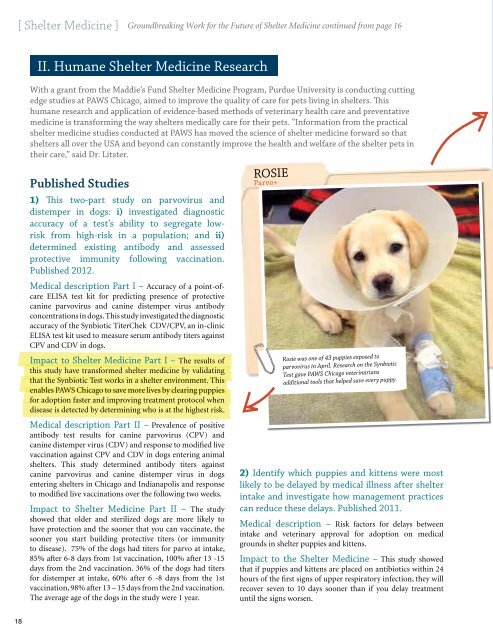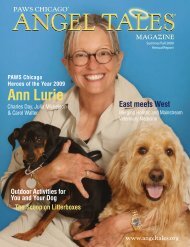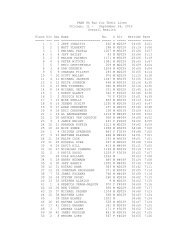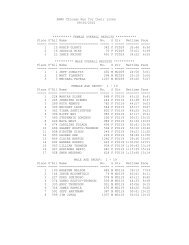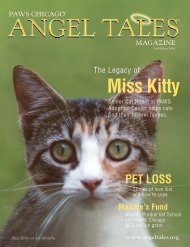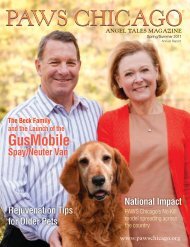DAVID DUFFIELD - PAWS Chicago
DAVID DUFFIELD - PAWS Chicago
DAVID DUFFIELD - PAWS Chicago
You also want an ePaper? Increase the reach of your titles
YUMPU automatically turns print PDFs into web optimized ePapers that Google loves.
[ Shelter Medicine ]<br />
II. Humane Shelter Medicine Research<br />
With a grant from the Maddie’s Fund Shelter Medicine Program, Purdue University is conducting cutting<br />
edge studies at <strong>PAWS</strong> <strong>Chicago</strong>, aimed to improve the quality of care for pets living in shelters. This<br />
humane research and application of evidence-based methods of veterinary health care and preventative<br />
medicine is transforming the way shelters medically care for their pets. “Information from the practical<br />
shelter medicine studies conducted at <strong>PAWS</strong> has moved the science of shelter medicine forward so that<br />
shelters all over the USA and beyond can constantly improve the health and welfare of the shelter pets in<br />
their care,” said Dr. Litster.<br />
Published Studies<br />
1) This two-part study on parvovirus and<br />
distemper in dogs: i) investigated diagnostic<br />
accuracy of a test’s ability to segregate lowrisk<br />
from high-risk in a population; and ii)<br />
determined existing antibody and assessed<br />
protective immunity following vaccination.<br />
Published 2012.<br />
Medical description Part I – Accuracy of a point-ofcare<br />
ELISA test kit for predicting presence of protective<br />
canine parvovirus and canine distemper virus antibody<br />
concentrations in dogs. This study investigated the diagnostic<br />
accuracy of the Synbiotic TiterChek CDV/CPV, an in-clinic<br />
ELISA test kit used to measure serum antibody titers against<br />
CPV and CDV in dogs.<br />
Impact to Shelter Medicine Part I – The results of<br />
this study have transformed shelter medicine by validating<br />
that the Synbiotic Test works in a shelter environment. This<br />
enables <strong>PAWS</strong> <strong>Chicago</strong> to save more lives by clearing puppies<br />
for adoption faster and improving treatment protocol when<br />
disease is detected by determining who is at the highest risk.<br />
Medical description Part II – Prevalence of positive<br />
antibody test results for canine parvovirus (CPV) and<br />
canine distemper virus (CDV) and response to modified live<br />
vaccination against CPV and CDV in dogs entering animal<br />
shelters. This study determined antibody titers against<br />
canine parvovirus and canine distemper virus in dogs<br />
entering shelters in <strong>Chicago</strong> and Indianapolis and response<br />
to modified live vaccinations over the following two weeks.<br />
Impact to Shelter Medicine Part II – The study<br />
showed that older and sterilized dogs are more likely to<br />
have protection and the sooner that you can vaccinate, the<br />
sooner you start building protective titers (or immunity<br />
to disease). 75% of the dogs had titers for parvo at intake,<br />
85% after 6-8 days from 1st vaccination, 100% after 13 -15<br />
days from the 2nd vaccination. 36% of the dogs had titers<br />
for distemper at intake, 60% after 6 -8 days from the 1st<br />
vaccination, 98% after 13 – 15 days from the 2nd vaccination.<br />
The average age of the dogs in the study were 1 year.<br />
Groundbreaking Work for the Future of Shelter Medicine continued from page 16<br />
ROSIE<br />
Parvo+<br />
Rosie was one of 43 puppies exposed to<br />
parvovirus in April. Research on the Synbiotic<br />
Test gave <strong>PAWS</strong> <strong>Chicago</strong> veterinarians<br />
additional tools that helped save every puppy.<br />
2) Identify which puppies and kittens were most<br />
likely to be delayed by medical illness after shelter<br />
intake and investigate how management practices<br />
can reduce these delays. Published 2011.<br />
Medical description – Risk factors for delays between<br />
intake and veterinary approval for adoption on medical<br />
grounds in shelter puppies and kittens.<br />
Impact to the Shelter Medicine – This study showed<br />
that if puppies and kittens are placed on antibiotics within 24<br />
hours of the first signs of upper respiratory infection, they will<br />
recover seven to 10 days sooner than if you delay treatment<br />
until the signs worsen.<br />
Real World Impact<br />
Determine Who is At Risk in a Parvo Outbreak<br />
Parvovirus is a deadly puppy disease that many shelters<br />
will immediately euthanize for to avoid it spreading through<br />
the population. <strong>PAWS</strong> <strong>Chicago</strong> has a 96% survival rate because<br />
of treatment protocols and immediate response.<br />
This study verified that in the event of a parvo outbreak,<br />
<strong>PAWS</strong> <strong>Chicago</strong> can test the population to see who is at risk.<br />
In April 2012, parvo struck <strong>PAWS</strong> <strong>Chicago</strong> and 43 puppies<br />
were exposed. By using the Synbiotic Test, <strong>PAWS</strong> veterinarians<br />
determined who was our high risk and needed intense medical<br />
treatment and who was low risk. Sixteen of the puppies had<br />
protection and went into foster homes, freeing up medical<br />
team time to focus on the puppies who most needed care. All<br />
the puppies survived and are living in loving homes today.<br />
Puppies are Cleared for Adoption Faster<br />
<strong>PAWS</strong> <strong>Chicago</strong> can now “fast track” puppies over the age<br />
of five months by using the Synbiotic Test. If a puppy has<br />
protective titers to parvo and distemper, they can be spayed or<br />
neutered and immediately transferred to the Adoption Center.<br />
Puppies without protective titers go into a foster home for two<br />
weeks to ensure they are protected from disease before being<br />
cleared for adoption and being exposed to other dogs.<br />
[ Shelter Medicine ]<br />
3) Determine the best antibiotic treatment for cats<br />
with upper respirator disease. Published 2012.<br />
Medical description – Comparison of the efficacy of<br />
amoxicillin-clavulanic acid, cefovecin, and doxycycline in the<br />
treatment of upper respiratory tract infections in cats housed in<br />
an animal shelter. This randomized prospective study identified<br />
the respiratory pathogens in <strong>Chicago</strong> cats and compared their<br />
response to three different antibiotic treatments.<br />
Impact to Shelter Medicine – This study showed that<br />
doxycycline was more effective than amoxycillian/clavulanate<br />
(clavamox) or cefovecin (convenia) in reducing clinical signs<br />
of upper respiratory tract infection, such as sneezing and eye<br />
discharge. This standardized <strong>PAWS</strong> <strong>Chicago</strong> antibiotic protocol<br />
for the treatment of upper respiratory and shortened cure time.<br />
Studies submitted to journals,<br />
currently under review<br />
1) Randomized masked controlled clinical trial to compare<br />
7-day and 14-day course length of doxycycline in the<br />
treatment of Mycoplasma felis infection in shelter cats. This<br />
randomized, blinded placebo–controlled trial compared oneweek<br />
and two-week course lengths for doxycycline treatment of<br />
Continued on page 20<br />
Get the free mobile app at<br />
http:/ / gettag.mobi<br />
18


